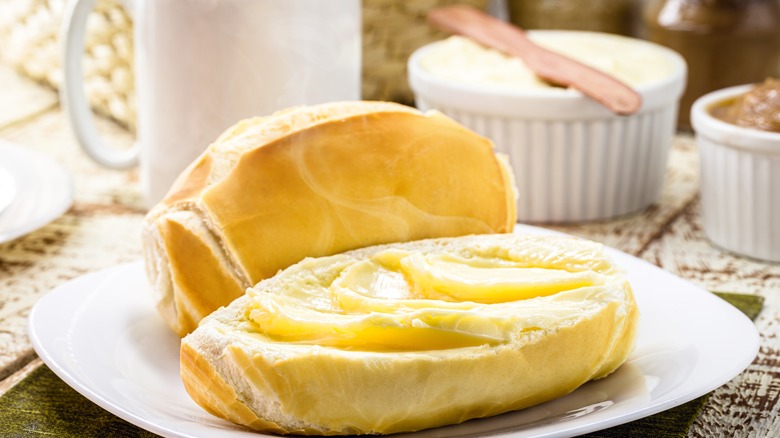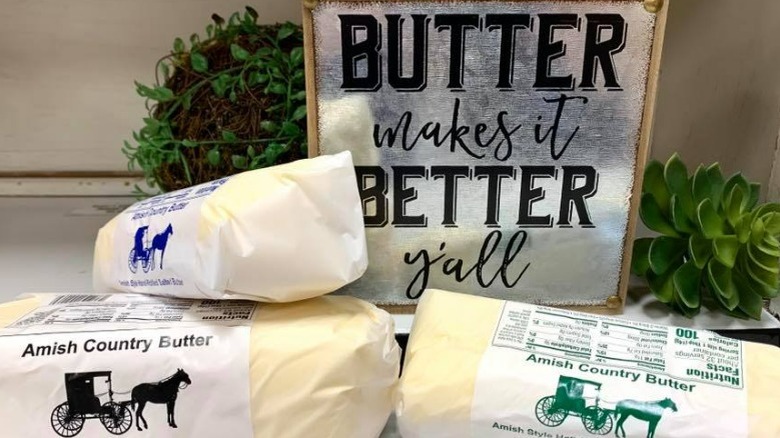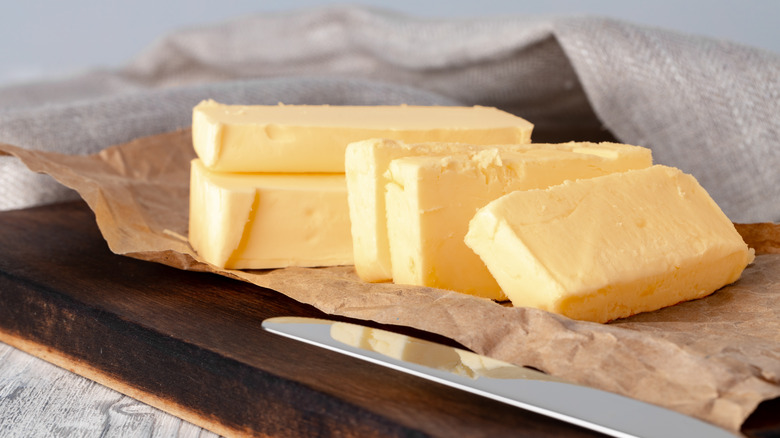What Is Hand-Rolled Butter And Does It Taste Better?
Butter is so common that it's almost inconceivable that you wouldn't have it in your home. Whether you're putting it on toast or making dough with it, you can do a whole lot with an average stick of butter. Yet, just as there are different varieties of wines, meats, and breads, you may be surprised to learn just how many types of butter there are.
You're probably familiar with butter that's either salted or unsalted and available at grocery stores across the country. You may have heard about grass-fed butter produced from the milk of cows fed a grass diet or a diet of grains. You may have also heard someone drop the term "cultured butter" if you're a fan of cooking shows. Cultured butter, rather than having an appreciation for opera, is butter that has "live culture" added to it (similar to how yogurt has live bacteria cultures) to give it a more pronounced taste. Although butter is produced using very similar ingredients and methods, this doesn't mean that all kinds of butter have the same tastes and textures.
But what exactly is "hand-rolled" butter? Where can you find it? Who makes it? And can you prepare hand-rolled butter at home?
Hand-rolled butter is associated with the Amish
When you think of the Amish, you usually think of horse-drawn wagons, butter churns, oil lanterns, and other modest technology-free ways of living. It would make sense, then, that hand-rolled butter, which, as the name implies, is butter rolled by hand, is widely associated with the Amish due in part to their separation from industrialized practices. You would be partly correct. It's not uncommon for the Amish to roll their butter by hand into large, round blocks, which are then sold in local shops and supermarkets. However, some types of butter use ingredients that are part of the industrialized process, such as pasteurized milk, or they must be tested for antibiotics as part of FDA standards.
How does hand-rolled butter compare to the usual store-bought butter? While taste-testing hand-rolled Amish butter, Kelly Vaughan of Real Simple described it as "complex, rich, slightly tangy, and incredibly creamy," with a milky and "natural flavor." This is presumably thanks to the higher butterfat content of Amish butter — 85 percent compared to the 80 percent butterfat found in most standard store-bought butter.
Hand-rolled butter can be purchased from many online retailers and stores but at a higher price than the kind of butter you can get at the grocery store. While it may be worth it, is there a way you can save money and make hand-rolled butter at home?
You need cream and salt to make homemade Amish butter
While the process of making butter may sound incredibly challenging, the good news is that it's a fairly simple process that requires very few ingredients and basic kitchen appliances. You'll also be relieved to know that you won't need a butter churner at any point — unless you really want to follow Amish tradition.
For a very basic recipe, add heavy cream and salt to a blender or food processor. As the cream and salt mixture is blended, it will form whipping cream. This isn't butter just yet, but it can be used in other recipes. Continue blending until the mixture firms up, and the "buttermilk" collects at the bottom of the vessel. From there, gather the butter and form it into a lump or ball before "washing" it in ice water. This involves squeezing out any excess buttermilk into the water, changing the water, and then repeating until the water runs clear. Then, you're free to roll the butter into any shape you please and freeze it for later use.
While this is a very simple, no-frills type of butter, mastering the butter-making process allows you to experiment with different kinds of ingredients. You could, for example, add sweeteners like honey or cinnamon or more savory ingredients like shredded cheese, herbs, and garlic.


